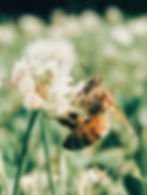- Jane Shellenberger
Coming to Life
by Jane Shellenberger:
On the plains in northern Colorado gardens are asleep under a few inches of snow but honeybees are stirring. My partner Oscar used to keep hives for several years. We liked to sit and observe them for at least a little while every day.

Once, as temperatures climbed after a frigid week, we watched several hundred bees tumble out the entrance to their boxes and buzz around the hive in a loose cluster. A few flew right into the snow and some landed, dazed, on their backs. They buzzed around upside down, digging themselves in deeper until they managed to either flip over or wear themselves out. Others crept around feebly, becoming colder and weaker. One theory suggests that bees mistake snow for the sky.
Our cat stalked the shaky, grounded bees, but Oscar held her off with snowballs. He picked up some bees and warmed them in bare, cupped hands. He says when they come to and fly off it feels as though he helped recharge their life force. We became attached to our bees. You might even call them cute when they alight at the hive entrance loaded down with pollen and waddle inside after a quick pat-down from the security guard bees.
When they joined us I noticed an increase in fruit production and learned about what bees like. Large swaths of plants make foraging more efficient and worthwhile than a just a few flowers; twenty lavenders attracts more bee attention than two. Fragrant linden blossoms make delicious honey and are one of the honeybee’s all time favorites. They also love early bloomers like Willows and Common Silver Buffaloberry, with flowers so subtle we don’t even notice them. Alliums of all kinds are bee magnets. And, along with sunflowers, tough, drought-tolerant Blue Mist Spirea (caryopteris x clandonensis ‘Blue Mist’) and native Dwarf Rabbitbrush that bloom from late summer into fall attract a crowd of eager bees of all types when fewer pollen and nectar sources are available. Modern hybrids with double flowers may look pretty, but they do nothing for bees.
Not everyone appreciates bees (or dandelions) the way beekeepers do. Most people mix them up with wasps and worry about getting stung. Oscar worried about “his” bees flying when it’s too cold or getting swept up by a sudden, strong gust of Chinook wind. And there is the continuing concern about bees disappearing and colonies collapsing. We had thought that several acres of alfalfa, dandelions, fruit trees, and lots of flowers would sustain them but our bees died each year. Boulder County, Colorado has a rich beekeeping history. Up until roughly 20 years ago, aerial crop spraying was a big problem and many hives succumbed. But with advance warning, beekeepers could at least move or cover hives.
As is true in most semi-rural areas, we’re not far from commercial agriculture. Several hundred acres lie just east of us, some of it always planted in feed corn. Spraying has given way to new seed coating technology. Virtually all major commercial, non-organic crop seed like corn and soybeans is now coated with a new class of insecticides. These neonicotinoid (derived from nicotine) insecticides become systemic throughout the plants as they grow so that even the pollen is toxic. They’re said to be relatively nontoxic to vertebrates, including humans, yet extremely effective against pest insects. They have been detected even in dandelions in field margins suggesting that plants take up the pesticide as it accumulates in soil.
We are killing off insects, the basic building block of the food chain, at an alarming rate: not only honeybees, bumblebees, and others that pollinate much of our food, but also spiders, caterpillars, earthworms, and microscopic soil creatures that transform organic waste into “black gold” for plants. Most birds depend on insects for food, especially when breeding and rearing their young.
Large scale, commercial farming methods bear much of the responsibility, but since urban and suburban yards now represent a large percentage of the habitat for pollinators and other insects, the practices of individual homeowners and gardeners really add up to a significant effect. If we seek out plants that support pollinators, plant some natives to sustain insect diversity, and pass up lawn and garden chemicals we can spark life in our gardens.



















